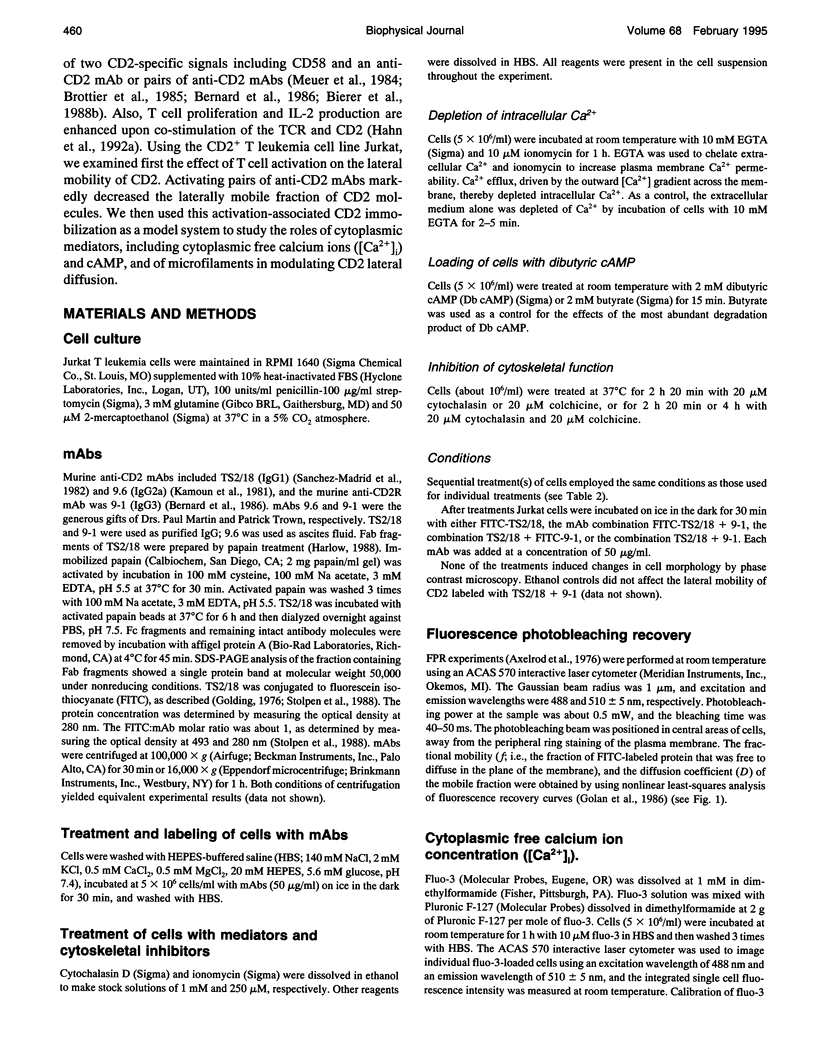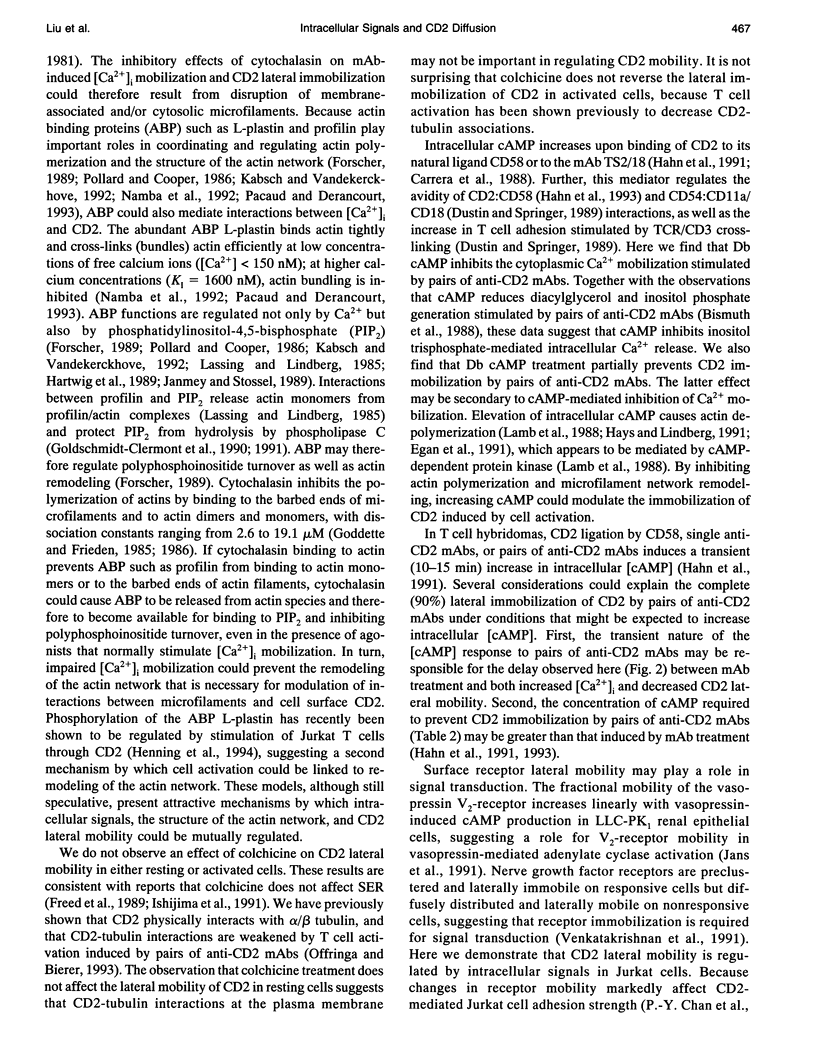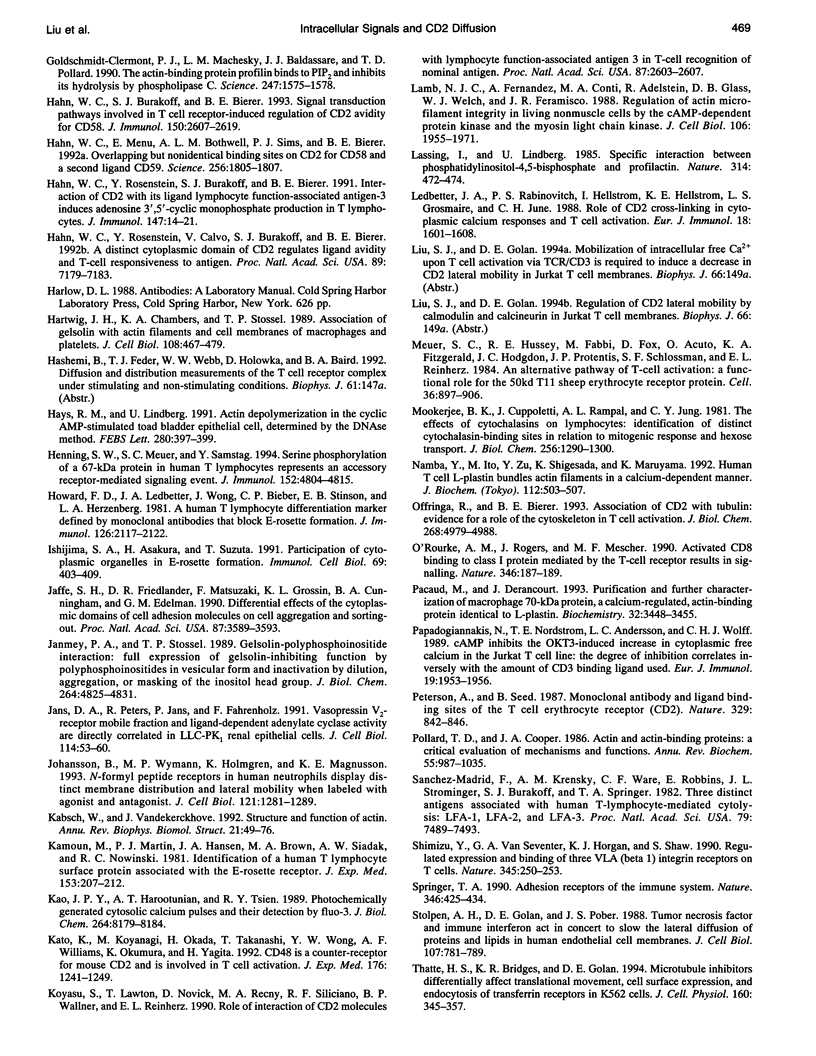Abstract
CD2 is a T cell surface glycoprotein that participates in T cell adhesion and activation. These processes are dynamically interrelated, in that T cell activation regulates the strength of CD2-mediated T cell adhesion. The lateral redistribution of CD2 and its ligand CD58 (LFA-3) in T cell and target membranes, respectively, has also been shown to affect cellular adhesion strength. We have used the fluorescence photobleaching recovery technique to measure the lateral mobility of CD2 in plasma membranes of resting and activated Jurkat T leukemia cells. CD2-mediated T cell activation caused lateral immobilization of 90% of cell surface CD2 molecules. Depleting cells of cytoplasmic Ca2+, loading cells with dibutyric cAMP, and disrupting cellular microfilaments each partially reversed the effect of CD2-mediated activation on the lateral mobility of CD2. These intracellular mediators apparently influence the same signal transduction pathways, because the effects of the mediators on CD2 lateral mobility were not additive. In separate experiments, activation-associated cytoplasmic Ca2+ mobilization was found to require microfilament integrity and to be negatively regulated by cAMP. By directly or indirectly controlling CD2 lateral diffusion and cell surface distribution, cytoplasmic Ca2+ mobilization may have an important regulatory role in CD2 mediated T cell adhesion.
Full text
PDF











Selected References
These references are in PubMed. This may not be the complete list of references from this article.
- Arulanandam A. R., Moingeon P., Concino M. F., Recny M. A., Kato K., Yagita H., Koyasu S., Reinherz E. L. A soluble multimeric recombinant CD2 protein identifies CD48 as a low affinity ligand for human CD2: divergence of CD2 ligands during the evolution of humans and mice. J Exp Med. 1993 May 1;177(5):1439–1450. doi: 10.1084/jem.177.5.1439. [DOI] [PMC free article] [PubMed] [Google Scholar]
- Axelrod D., Koppel D. E., Schlessinger J., Elson E., Webb W. W. Mobility measurement by analysis of fluorescence photobleaching recovery kinetics. Biophys J. 1976 Sep;16(9):1055–1069. doi: 10.1016/S0006-3495(76)85755-4. [DOI] [PMC free article] [PubMed] [Google Scholar]
- Bernard A., Knowles R. W., Naito K., Dupont B., Raynal B., Tran H. C., Boumsell L. A unique epitope on the CD2 molecule defined by the monoclonal antibody 9-1: epitope-specific modulation of the E-rosette receptor and effects on T-cell functions. Hum Immunol. 1986 Dec;17(4):388–405. doi: 10.1016/0198-8859(86)90299-5. [DOI] [PubMed] [Google Scholar]
- Bierer B. E., Peterson A., Barbosa J., Seed B., Burakoff S. J. Expression of the T-cell surface molecule CD2 and an epitope-loss CD2 mutant to define the role of lymphocyte function-associated antigen 3 (LFA-3) in T-cell activation. Proc Natl Acad Sci U S A. 1988 Feb;85(4):1194–1198. doi: 10.1073/pnas.85.4.1194. [DOI] [PMC free article] [PubMed] [Google Scholar]
- Bierer B. E., Peterson A., Gorga J. C., Herrmann S. H., Burakoff S. J. Synergistic T cell activation via the physiological ligands for CD2 and the T cell receptor. J Exp Med. 1988 Sep 1;168(3):1145–1156. doi: 10.1084/jem.168.3.1145. [DOI] [PMC free article] [PubMed] [Google Scholar]
- Bismuth G., Theodorou I., Gouy H., Le Gouvello S., Bernard A., Debré P. Cyclic AMP-mediated alteration of the CD2 activation process in human T lymphocytes. Preferential inhibition of the phosphoinositide cycle-related transduction pathway. Eur J Immunol. 1988 Sep;18(9):1351–1357. doi: 10.1002/eji.1830180908. [DOI] [PubMed] [Google Scholar]
- Brottier P., Boumsell L., Gelin C., Bernard A. T cell activation via CD2 [T, gp50] molecules: accessory cells are required to trigger T cell activation via CD2-D66 plus CD2-9.6/T11(1) epitopes. J Immunol. 1985 Sep;135(3):1624–1631. [PubMed] [Google Scholar]
- Carpén O., Pallai P., Staunton D. E., Springer T. A. Association of intercellular adhesion molecule-1 (ICAM-1) with actin-containing cytoskeleton and alpha-actinin. J Cell Biol. 1992 Sep;118(5):1223–1234. doi: 10.1083/jcb.118.5.1223. [DOI] [PMC free article] [PubMed] [Google Scholar]
- Carrera A. C., Rincón M., De Landázuri M. O., López-Botet M. CD2 is involved in regulating cyclic AMP levels in T cells. Eur J Immunol. 1988 Jun;18(6):961–964. doi: 10.1002/eji.1830180620. [DOI] [PubMed] [Google Scholar]
- Chan B. M., Wong J. G., Rao A., Hemler M. E. T cell receptor-dependent, antigen-specific stimulation of a murine T cell clone induces a transient, VLA protein-mediated binding to extracellular matrix. J Immunol. 1991 Jul 15;147(2):398–404. [PubMed] [Google Scholar]
- Chan P. Y., Lawrence M. B., Dustin M. L., Ferguson L. M., Golan D. E., Springer T. A. Influence of receptor lateral mobility on adhesion strengthening between membranes containing LFA-3 and CD2. J Cell Biol. 1991 Oct;115(1):245–255. doi: 10.1083/jcb.115.1.245. [DOI] [PMC free article] [PubMed] [Google Scholar]
- Chopra H., Hatfield J. S., Chang Y. S., Grossi I. M., Fitzgerald L. A., O'Gara C. Y., Marnett L. J., Diglio C. A., Taylor J. D., Honn K. V. Role of tumor cytoskeleton and membrane glycoprotein IRGpIIb/IIIa in platelet adhesion to tumor cell membrane and tumor cell-induced platelet aggregation. Cancer Res. 1988 Jul 1;48(13):3787–3800. [PubMed] [Google Scholar]
- Deckert M., Kubar J., Zoccola D., Bernard-Pomier G., Angelisova P., Horejsi V., Bernard A. CD59 molecule: a second ligand for CD2 in T cell adhesion. Eur J Immunol. 1992 Nov;22(11):2943–2947. doi: 10.1002/eji.1830221128. [DOI] [PubMed] [Google Scholar]
- Dustin M. L., Springer T. A. T-cell receptor cross-linking transiently stimulates adhesiveness through LFA-1. Nature. 1989 Oct 19;341(6243):619–624. doi: 10.1038/341619a0. [DOI] [PubMed] [Google Scholar]
- Egan J. J., Gronowicz G., Rodan G. A. Parathyroid hormone promotes the disassembly of cytoskeletal actin and myosin in cultured osteoblastic cells: mediation by cyclic AMP. J Cell Biochem. 1991 Jan;45(1):101–111. doi: 10.1002/jcb.240450117. [DOI] [PubMed] [Google Scholar]
- Forscher P. Calcium and polyphosphoinositide control of cytoskeletal dynamics. Trends Neurosci. 1989 Nov;12(11):468–474. doi: 10.1016/0166-2236(89)90098-2. [DOI] [PubMed] [Google Scholar]
- Freed B. M., Lempert N., Lawrence D. A. The inhibitory effects of N-ethylmaleimide, colchicine and cytochalasins on human T-cell functions. Int J Immunopharmacol. 1989;11(5):459–465. doi: 10.1016/0192-0561(89)90174-4. [DOI] [PubMed] [Google Scholar]
- Goddette D. W., Frieden C. The binding of cytochalasin D to monomeric actin. Biochem Biophys Res Commun. 1985 May 16;128(3):1087–1092. doi: 10.1016/0006-291x(85)91051-4. [DOI] [PubMed] [Google Scholar]
- Goddette D. W., Frieden C. The kinetics of cytochalasin D binding to monomeric actin. J Biol Chem. 1986 Dec 5;261(34):15970–15973. [PubMed] [Google Scholar]
- Goding J. W. Conjugation of antibodies with fluorochromes: modifications to the standard methods. J Immunol Methods. 1976;13(3-4):215–226. doi: 10.1016/0022-1759(76)90068-5. [DOI] [PubMed] [Google Scholar]
- Golan D. E., Brown C. S., Cianci C. M., Furlong S. T., Caulfield J. P. Schistosomula of Schistosoma mansoni use lysophosphatidylcholine to lyse adherent human red blood cells and immobilize red cell membrane components. J Cell Biol. 1986 Sep;103(3):819–828. doi: 10.1083/jcb.103.3.819. [DOI] [PMC free article] [PubMed] [Google Scholar]
- Goldschmidt-Clermont P. J., Kim J. W., Machesky L. M., Rhee S. G., Pollard T. D. Regulation of phospholipase C-gamma 1 by profilin and tyrosine phosphorylation. Science. 1991 Mar 8;251(4998):1231–1233. doi: 10.1126/science.1848725. [DOI] [PubMed] [Google Scholar]
- Goldschmidt-Clermont P. J., Machesky L. M., Baldassare J. J., Pollard T. D. The actin-binding protein profilin binds to PIP2 and inhibits its hydrolysis by phospholipase C. Science. 1990 Mar 30;247(4950):1575–1578. doi: 10.1126/science.2157283. [DOI] [PubMed] [Google Scholar]
- Hahn W. C., Burakoff S. J., Bierer B. E. Signal transduction pathways involved in T cell receptor-induced regulation of CD2 avidity for CD58. J Immunol. 1993 Apr 1;150(7):2607–2619. [PubMed] [Google Scholar]
- Hahn W. C., Menu E., Bothwell A. L., Sims P. J., Bierer B. E. Overlapping but nonidentical binding sites on CD2 for CD58 and a second ligand CD59. Science. 1992 Jun 26;256(5065):1805–1807. doi: 10.1126/science.1377404. [DOI] [PubMed] [Google Scholar]
- Hahn W. C., Rosenstein Y., Burakoff S. J., Bierer B. E. Interaction of CD2 with its ligand lymphocyte function-associated antigen-3 induces adenosine 3',5'-cyclic monophosphate production in T lymphocytes. J Immunol. 1991 Jul 1;147(1):14–21. [PubMed] [Google Scholar]
- Hahn W. C., Rosenstein Y., Calvo V., Burakoff S. J., Bierer B. E. A distinct cytoplasmic domain of CD2 regulates ligand avidity and T-cell responsiveness to antigen. Proc Natl Acad Sci U S A. 1992 Aug 1;89(15):7179–7183. doi: 10.1073/pnas.89.15.7179. [DOI] [PMC free article] [PubMed] [Google Scholar]
- Hartwig J. H., Chambers K. A., Stossel T. P. Association of gelsolin with actin filaments and cell membranes of macrophages and platelets. J Cell Biol. 1989 Feb;108(2):467–479. doi: 10.1083/jcb.108.2.467. [DOI] [PMC free article] [PubMed] [Google Scholar]
- Hays R. M., Lindberg U. Actin depolymerization in the cyclic AMP-stimulated toad bladder epithelial cell, determined by the DNAse method. FEBS Lett. 1991 Mar 25;280(2):397–399. doi: 10.1016/0014-5793(91)80340-9. [DOI] [PubMed] [Google Scholar]
- Henning S. W., Meuer S. C., Samstag Y. Serine phosphorylation of a 67-kDa protein in human T lymphocytes represents an accessory receptor-mediated signaling event. J Immunol. 1994 May 15;152(10):4808–4815. [PubMed] [Google Scholar]
- Howard F. D., Ledbetter J. A., Wong J., Bieber C. P., Stinson E. B., Herzenberg L. A. A human T lymphocyte differentiation marker defined by monoclonal antibodies that block E-rosette formation. J Immunol. 1981 Jun;126(6):2117–2122. [PubMed] [Google Scholar]
- Ishijima S. A., Asakura H., Suzuta T. Participation of cytoplasmic organelles in E-rosette formation. Immunol Cell Biol. 1991 Dec;69(Pt 6):403–409. doi: 10.1038/icb.1991.57. [DOI] [PubMed] [Google Scholar]
- Jaffe S. H., Friedlander D. R., Matsuzaki F., Crossin K. L., Cunningham B. A., Edelman G. M. Differential effects of the cytoplasmic domains of cell adhesion molecules on cell aggregation and sorting-out. Proc Natl Acad Sci U S A. 1990 May;87(9):3589–3593. doi: 10.1073/pnas.87.9.3589. [DOI] [PMC free article] [PubMed] [Google Scholar]
- Janmey P. A., Stossel T. P. Gelsolin-polyphosphoinositide interaction. Full expression of gelsolin-inhibiting function by polyphosphoinositides in vesicular form and inactivation by dilution, aggregation, or masking of the inositol head group. J Biol Chem. 1989 Mar 25;264(9):4825–4831. [PubMed] [Google Scholar]
- Jans D. A., Peters R., Jans P., Fahrenholz F. Vasopressin V2-receptor mobile fraction and ligand-dependent adenylate cyclase activity are directly correlated in LLC-PK1 renal epithelial cells. J Cell Biol. 1991 Jul;114(1):53–60. doi: 10.1083/jcb.114.1.53. [DOI] [PMC free article] [PubMed] [Google Scholar]
- Johansson B., Wymann M. P., Holmgren-Peterson K., Magnusson K. E. N-formyl peptide receptors in human neutrophils display distinct membrane distribution and lateral mobility when labeled with agonist and antagonist. J Cell Biol. 1993 Jun;121(6):1281–1289. doi: 10.1083/jcb.121.6.1281. [DOI] [PMC free article] [PubMed] [Google Scholar]
- Kabsch W., Vandekerckhove J. Structure and function of actin. Annu Rev Biophys Biomol Struct. 1992;21:49–76. doi: 10.1146/annurev.bb.21.060192.000405. [DOI] [PubMed] [Google Scholar]
- Kamoun M., Martin P. J., Hansen J. A., Brown M. A., Siadak A. W., Nowinski R. C. Identification of a human T lymphocyte surface protein associated with the E-rosette receptor. J Exp Med. 1981 Jan 1;153(1):207–212. doi: 10.1084/jem.153.1.207. [DOI] [PMC free article] [PubMed] [Google Scholar]
- Kao J. P., Harootunian A. T., Tsien R. Y. Photochemically generated cytosolic calcium pulses and their detection by fluo-3. J Biol Chem. 1989 May 15;264(14):8179–8184. [PubMed] [Google Scholar]
- Kato K., Koyanagi M., Okada H., Takanashi T., Wong Y. W., Williams A. F., Okumura K., Yagita H. CD48 is a counter-receptor for mouse CD2 and is involved in T cell activation. J Exp Med. 1992 Nov 1;176(5):1241–1249. doi: 10.1084/jem.176.5.1241. [DOI] [PMC free article] [PubMed] [Google Scholar]
- Koyasu S., Lawton T., Novick D., Recny M. A., Siliciano R. F., Wallner B. P., Reinherz E. L. Role of interaction of CD2 molecules with lymphocyte function-associated antigen 3 in T-cell recognition of nominal antigen. Proc Natl Acad Sci U S A. 1990 Apr;87(7):2603–2607. doi: 10.1073/pnas.87.7.2603. [DOI] [PMC free article] [PubMed] [Google Scholar]
- Lamb N. J., Fernandez A., Conti M. A., Adelstein R., Glass D. B., Welch W. J., Feramisco J. R. Regulation of actin microfilament integrity in living nonmuscle cells by the cAMP-dependent protein kinase and the myosin light chain kinase. J Cell Biol. 1988 Jun;106(6):1955–1971. doi: 10.1083/jcb.106.6.1955. [DOI] [PMC free article] [PubMed] [Google Scholar]
- Lassing I., Lindberg U. Specific interaction between phosphatidylinositol 4,5-bisphosphate and profilactin. Nature. 1985 Apr 4;314(6010):472–474. doi: 10.1038/314472a0. [DOI] [PubMed] [Google Scholar]
- Ledbetter J. A., Rabinovitch P. S., Hellström I., Hellström K. E., Grosmaire L. S., June C. H. Role of CD2 cross-linking in cytoplasmic calcium responses and T cell activation. Eur J Immunol. 1988 Oct;18(10):1601–1608. doi: 10.1002/eji.1830181020. [DOI] [PubMed] [Google Scholar]
- Meuer S. C., Hussey R. E., Fabbi M., Fox D., Acuto O., Fitzgerald K. A., Hodgdon J. C., Protentis J. P., Schlossman S. F., Reinherz E. L. An alternative pathway of T-cell activation: a functional role for the 50 kd T11 sheep erythrocyte receptor protein. Cell. 1984 Apr;36(4):897–906. doi: 10.1016/0092-8674(84)90039-4. [DOI] [PubMed] [Google Scholar]
- Mookerjee B. K., Cuppoletti J., Rampal A. L., Jung C. Y. The effects of cytochalasins on lymphocytes. Identification of distinct cytochalasin-binding sites in relation to mitogenic response and hexose transport. J Biol Chem. 1981 Feb 10;256(3):1290–1300. [PubMed] [Google Scholar]
- Namba Y., Ito M., Zu Y., Shigesada K., Maruyama K. Human T cell L-plastin bundles actin filaments in a calcium-dependent manner. J Biochem. 1992 Oct;112(4):503–507. doi: 10.1093/oxfordjournals.jbchem.a123929. [DOI] [PubMed] [Google Scholar]
- O'Rourke A. M., Rogers J., Mescher M. F. Activated CD8 binding to class I protein mediated by the T-cell receptor results in signalling. Nature. 1990 Jul 12;346(6280):187–189. doi: 10.1038/346187a0. [DOI] [PubMed] [Google Scholar]
- Offringa R., Bierer B. E. Association of CD2 with tubulin. Evidence for a role of the cytoskeleton in T cell activation. J Biol Chem. 1993 Mar 5;268(7):4979–4988. [PubMed] [Google Scholar]
- Pacaud M., Derancourt J. Purification and further characterization of macrophage 70-kDa protein, a calcium-regulated, actin-binding protein identical to L-plastin. Biochemistry. 1993 Apr 6;32(13):3448–3455. doi: 10.1021/bi00064a031. [DOI] [PubMed] [Google Scholar]
- Papadogiannakis N., Nordström T. E., Andersson L. C., Wolff C. H. cAMP inhibits the OKT3-induced increase in cytoplasmic free calcium in the Jurkat T cell line: the degree of inhibition correlates inversely with the amount of CD3 binding ligand used. Eur J Immunol. 1989 Oct;19(10):1953–1956. doi: 10.1002/eji.1830191029. [DOI] [PubMed] [Google Scholar]
- Peterson A., Seed B. Monoclonal antibody and ligand binding sites of the T cell erythrocyte receptor (CD2). 1987 Oct 29-Nov 4Nature. 329(6142):842–846. doi: 10.1038/329842a0. [DOI] [PubMed] [Google Scholar]
- Pollard T. D., Cooper J. A. Actin and actin-binding proteins. A critical evaluation of mechanisms and functions. Annu Rev Biochem. 1986;55:987–1035. doi: 10.1146/annurev.bi.55.070186.005011. [DOI] [PubMed] [Google Scholar]
- Sanchez-Madrid F., Krensky A. M., Ware C. F., Robbins E., Strominger J. L., Burakoff S. J., Springer T. A. Three distinct antigens associated with human T-lymphocyte-mediated cytolysis: LFA-1, LFA-2, and LFA-3. Proc Natl Acad Sci U S A. 1982 Dec;79(23):7489–7493. doi: 10.1073/pnas.79.23.7489. [DOI] [PMC free article] [PubMed] [Google Scholar]
- Shimizu Y., Van Seventer G. A., Horgan K. J., Shaw S. Regulated expression and binding of three VLA (beta 1) integrin receptors on T cells. Nature. 1990 May 17;345(6272):250–253. doi: 10.1038/345250a0. [DOI] [PubMed] [Google Scholar]
- Springer T. A. Adhesion receptors of the immune system. Nature. 1990 Aug 2;346(6283):425–434. doi: 10.1038/346425a0. [DOI] [PubMed] [Google Scholar]
- Stolpen A. H., Golan D. E., Pober J. S. Tumor necrosis factor and immune interferon act in concert to slow the lateral diffusion of proteins and lipids in human endothelial cell membranes. J Cell Biol. 1988 Aug;107(2):781–789. doi: 10.1083/jcb.107.2.781. [DOI] [PMC free article] [PubMed] [Google Scholar]
- Thatte H. S., Bridges K. R., Golan D. E. Microtubule inhibitors differentially affect translational movement, cell surface expression, and endocytosis of transferrin receptors in K562 cells. J Cell Physiol. 1994 Aug;160(2):345–357. doi: 10.1002/jcp.1041600216. [DOI] [PubMed] [Google Scholar]
- Van Wauwe J., Goossens J., Decock W., Kung P., Goldstein G. Suppression of human T-cell mitogenesis and E-rosette formation by the monoclonal antibody OKT11A. Immunology. 1981 Dec;44(4):865–871. [PMC free article] [PubMed] [Google Scholar]
- Venkatakrishnan G., McKinnon C. A., Pilapil C. G., Wolf D. E., Ross A. H. Nerve growth factor receptors are preaggregated and immobile on responsive cells. Biochemistry. 1991 Mar 19;30(11):2748–2753. doi: 10.1021/bi00225a002. [DOI] [PubMed] [Google Scholar]
- Yang S. Y., Chouaib S., Dupont B. A common pathway for T lymphocyte activation involving both the CD3-Ti complex and CD2 sheep erythrocyte receptor determinants. J Immunol. 1986 Aug 15;137(4):1097–1100. [PubMed] [Google Scholar]
- van Kooyk Y., van de Wiel-van Kemenade P., Weder P., Kuijpers T. W., Figdor C. G. Enhancement of LFA-1-mediated cell adhesion by triggering through CD2 or CD3 on T lymphocytes. Nature. 1989 Dec 14;342(6251):811–813. doi: 10.1038/342811a0. [DOI] [PubMed] [Google Scholar]


